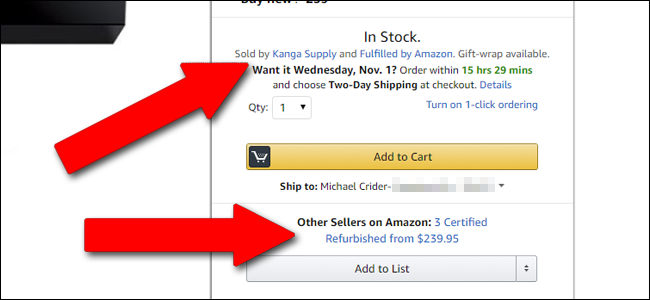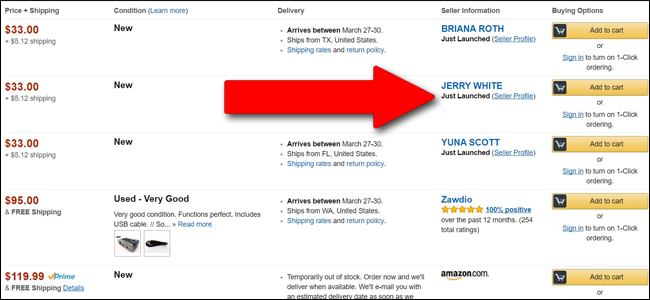Quick Links
Amazon is one of the biggest direct-to-consumer marketplaces on the planet. And not just of its own goods and services: though the company operates huge warehouses all over the world, it also lets smaller companies sell harder-to-find items on its marketplace, including individual sellers of new and used items. But with a relatively wide-open policy towards third party sellers, a few with less than noble intentions are sure to slip through the cracks. Here's how to spot them.
Check the Listing for "Fulfilled by Amazon"
Third-party sellers show up in the main search results when Amazon doesn't sell that particular item. Occasionally, if the third party is selling for lower than Amazon itself, it will be the default listing. (Amazon's third-party sellers call this "winning the buy box.") At all other times, you can find third parties under the link for "Other Sellers on Amazon."
For the most part, these are either companies that are simply using Amazon as a secondary marketplace for visibility, retail stores that want to find a larger audience (like pawn shops listing their inventory), or simply individuals listing their items for sale, like Craigslist or eBay. Generally these items are perfectly legitimate, but this page is also where most of the fakes on Amazon are going to be lurking.
There's a middle ground here that's somewhat safer: products that are "Fulfilled by Amazon." If an item is marked as sold by [company name] and Fulfilled by Amazon (note the capital letter), it's been shipped to an Amazon warehouse and checked beforehand. If anything goes wrong with this item (which can still happen), Amazon will generally be very quick to resolve the issue. Items which aren't coming from an Amazon distribution center, instead being shipped directly from the independent seller, will be marked with "shipped from and sold by 'company name.'"
If a Price Seems Too Good to Be True, It Probably Is
Just like pretty much any exchange market for the last few thousand years, hucksters on Amazon know that the best way to catch the eye of buyers is with a good price. Amazon often offers items for sale at a significant discount over other vendors thanks to bulk purchasing and efficient distributing, but if you see something for sale from a non-Amazon vendor that's marked at half off the regular price or more, be extra careful. If it's combined with one or more of the red flags elsewhere on this list, it's not worth the risk.
New Accounts May Be Illegitimate
Despite being inundated with fake sellers and accounts, Amazon is surprisingly diligent in policing its marketplace: if it sees a spike in reports, it will remove a seller's privileges without hesitation. To combat this, fake sellers play the numbers game and run multiple accounts at a time. This means that the majority of scammers don't keep an active account for more than a few days, two weeks at most. So it follows that almost all of the truly fraudulent sellers on the site will be labelled with the "just launched" badge on item listings and on their seller profile. Again, just because a seller is new doesn't mean it's illegitimate...but combined with other warning signs, it's a good reason to steer clear.
Odd Spelling and Grammar is a Warning Sign
In addition to manual reviews and takedowns, Amazon runs automated behind-the-scenes checks to keep fake sellers away once they've been kicked. Just like emails trying to get through a spam filter, vendors will fill their supplied Amazon names with alternate characters and deliberate misspellings to get through Amazon's defenses. Sometimes they'll simply use random groups of characters, like "aef43tsrf8." If the name of the vendor is something that looks like it was typed by a drunk monkey, it's probably fake.
Watch for Extra-Long Ship Times
Even though customers pay for their items right away, Third-party sellers on Amazon don't get paid immediately: the income from their item sales are credited to their bank accounts every fourteen days. So a new vendor with fake merchandise has to keep up at least the image of propriety for two weeks before Amazon will release any of the money they've "earned." To forestall customer complaints of missing items, they'll often set the shipping time for more than the Amazon processing time, i.e., three to four weeks. This lets them make off with your money (and Amazon's) before anyone gets suspicious.
Now there are certainly items that are backordered for three weeks or more, and there's certainly cases where international shipping takes that long. But if a third-party seller in your country says it's going to take a month for an in-stock item to get to you (especially if they issue a shipping confirmation right away), you may just be looking at a fake.
Check the Seller Reviews
Just like most items on the Internet, seller reviews on Amazon are easy to fake. Sellers will buy up items from themselves dozens of times right away, using their own money to pay themselves without ever shipping any products, leaving fake reviews from multiple accounts on their seller profiles. Check a seller's reviews (not the reviews for the item itself) using the same techniques as you do on other websites, especially if you see multiple identical or single-word user responses.
The good news is that Amazon seems to be taking fake sellers more seriously than they used to---formerly I saw them on a fairly regular basis, but I had trouble even finding relevant examples for this article. The better news is that Amazon guards its reputation fiercely. If you've been scammed by a fake seller that disappears into the night, just contact Amazon's customer service department: odds are pretty good that they'll be eager to return your money.
Image credit: Amazon seller forum, Malik Earnest



